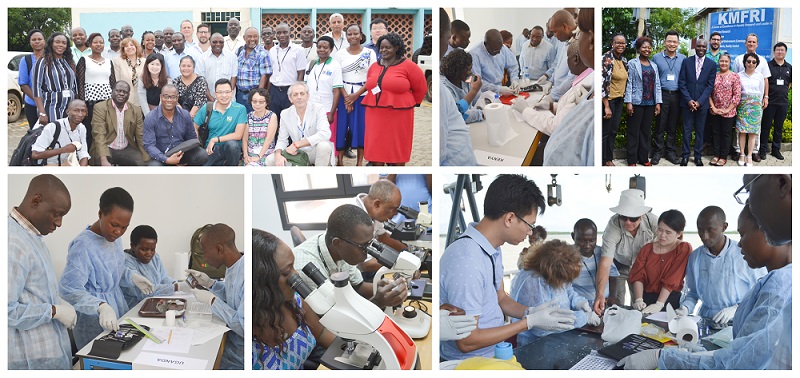Table of materials and presentations
 |
| 10-day intensive TiLV course delivered by FAO experts to delegates from 6 participating countries: Angola, Ghana, Egypt, Kenya, Nigeria, Uganda under the project GCP/RAF/510/MUL: Enhancing capacity/risk reduction of emerging Tilapia Lake Virus (TiLV) to African tilapia aquaculture funded by the Africa Solidarity Trust Fund. |
A 10-day intensive training course on TiLV was held from 4-13 December 2018 in Kisumu, Kenya in collaboration with the Kenya Marine and Fisheries Research Institute and the Kenya Fisheries Service. Some 34 delegates from Angola, Egypt, Ghana, Kenya, Nigeria, Uganda; delegates and officials of Kenya's Ministry of Agriculture, Livestock, Fisheries and Irrigation, academe and producer sector representatives; officials of FAOR Kenya, FAOHQ and FAO experts actively contributed to the successful completion of the course. This activity is under the auspices of GCP/RAF/510/MUL: Enhancing capacity/risk reduction of emerging Tilapia Lake Virus (TiLV) to African tilapia aquaculture funded by the Africa Solidarity Trust Fund.
The course consisted of 14 sessions, namely:
Session 1: Country updates on National Action Plans (NAPs) on TiLV; Session 2: Diseases of aquatic animals; Session 3: Water quality; Session 4: Tilapia biology and aquaculture; Session 5: Field and laboratory checklist; Session 6: What is currently known about TiLV; Session 7: TiLV diagnostics; Session 8: Preparation for field work (all experts/participants); Session 9: Disease surveillance; Session 10: Socio-economic impact assessment; Session 11: TiLVRisk assessment; Session 12: Individual country work on NAP on TiLVand implementation; Session 13: Emergency preparedness and response; Session 14: Conclusions and the Way Forward.
The delegates prepared a detailed country level implementation of the TiLV National Action Plan (NAP): Diagnostics, Surveillance, Information dissemination, National consultation, Emergency preparedness that is expected to be carried out between January and December 2019; with field/laboratory work commencing on March 2019. It is anticipated that a possible Second regional Workshop: Analysis of surveillance data and implementation of TiLV NAP will be undertaken towards the end of 2019 or in 2020 back-to-back with a planned International Technical Seminar on TiLV. The closing ceremony was graced by FAO Representative to Kenya, Dr Gabriel Rugalema, who delivered a very inspiring speech and handed the certificates of attendance to all participants.
Impression from one of the participants:
"Having taken 60 hours of Lectures, 8 hours of Practicals and 8 Hours Field (work on Lake Victoria), I graduated on Thursday 13th December 2018 and was awarded a certificate. We were all attentive, none missed a lecture, we began on time, ended without complain and above all Melba was in every Session and at the end of it gave a summary or additional notes on what the experts taught. It was a wonderful experience; rejuvenating old minds and taught us more than Epidemiology! We interacted, learned more about our Africa and above all made friendship that will generate more collaborations and linkages. I can go on and on but I learned so much from all of you." (Charles Ngugi, Mwea AquaFish Farm, Kenya)